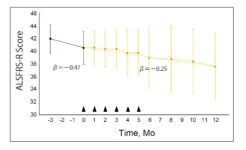(Press-News.org) Black, indigenous, and people of color (BIPOC) who were infected with COVID-19 experienced greater negative aftereffects in health and work loss than did similarly infected white participants, new research finds.
Despite similar symptom prevalence, BIPOC and Hispanic patients experienced greater negative impacts on their health status, activity levels, and ability to work compared with non-Hispanic and white patients participating in the ongoing multi-site INSPIRE clinical trial examining people with long COVID.
The findings are published in the journal Frontiers in Public Health.
“We must understand what is driving these differences in order to advance health equity after infection,” said Dr. Joann Elmore, principal investigator of the UCLA INSPIRE study site and a professor of medicine in the division of general internal medicine and health services research at the David Geffen School of Medicine at UCLA. “Several minority populations reported worse overall health, lower activity levels, or more missed work months after infection. While we can’t pinpoint the cause, we know that, historically, these populations may have a harder time accessing health care, which could complicate their recovery.”
INSPIRE, funded by the Centers for Disease Control and Prevention, is a collaboration of eight geographically diverse major academic medical centers, including UCLA Health, seeking to better understand the long-term effects of COVID-19. INSPIRE participants self-reported their symptoms in a standardized questionnaire. The INSPIRE group has been studying COVID-19 since the first documented U.S. case was found just outside the Seattle area in January 2020. This is the seventh research study released by the INSPIRE group.
For this latest study, the authors investigated the longer-term impacts of acute COVID-19 infection across ethnic and racial groups. They longitudinally followed 2,402 U.S. individuals first infected between 2020 and 2022. Study participants were asked to record their symptoms from a list of 22, including loss of taste, shortness of breath, and sore throat. While the investigators found few symptomatic differences across the groups at three- and six-months after infection, there were significant health effects and work loss among BIPOC populations.
The researchers suggest that some of these negative outcomes among BIPOC participants — when compared with those of non-Hispanic and white participants — may be associated with socioeconomic disparities.
“Certain demographic groups may be overrepresented in front-line work industries,” said Dr. Michelle L’Hommedieu, project director for the UCLA INSPIRE study and co-author on this paper. ”Keep in mind that individuals in these groups may not have had the option to work from home, which may have increased their risk of infection.”
Other differences across population groups might stem from the lack of health insurance, mistrust of the medical establishment, cultural or institutional racism, medical deserts, or the lack of safe parks or green spaces where study participants live, the researchers noted.
Among the findings:
Hispanic participants were about twice as likely as non-Hispanic counterparts to self-report fair or poor health and much lower activity levels at three months. These differences, however, were no longer present at six months.
Compared with white participants, those who identified as “other/multiple race” were nearly twice as likely to report fair or poor health and describe that they were somewhat or much less active at three months. These differences persisted at 6 months. The “other/multiple race” group included individuals identifying as American Indian or Alaska Native, Native Hawaiian or Pacific Islander or selecting two or more races.
Compared with white participants, Asian participants’ chances of reporting fair/poor health was similar at three months, but Asian participants were more likely to report fair/poor health at six months.
Reports of more than five missed workdays was similar across all race groups at three months; at six months, however, reports of missed work were almost three times higher among Black participants and two times higher other/multiple race participants.
The researchers described these differences in the context of accounting for other demographic factors that affect populations, such as social determinants of health, substance use, preexisting health conditions, and COVID-19 vaccination status.
“Our hope is that these findings will inform equitable health interventions for underserved populations who are still navigating the post-COVID experience,” Elmore said.
This work was supported by the Centers for Disease Control and Prevention, National Center for Immunization and Respiratory Diseases (75D30120C08008).
END
BIPOC individuals bear greater post-COVID health burdens, new research suggests
Compared with whites and non-Hispanics, BIPOC and Hispanic patients experienced greater negative impacts despite similar symptom prevalence among the groups
2024-02-01
ELSE PRESS RELEASES FROM THIS DATE:
National Academy of Medicine member new president of The Obesity Society
2024-02-01
ROCKVILLE, Md. — A member of the National Academy of Medicine is the new president of The Obesity Society (TOS), the organization announced today.
Jamy Ard, MD, FTOS, is professor in the Departments of Epidemiology and Prevention and Internal Medicine and vice dean of Clinical Research at Wake Forest University School of Medicine in Winston-Salem, N.C. He also co-directs the Atrium Health Wake Forest Baptist Weight Management Center, where he oversees medical weight management programs.
“I am honored to serve as president of ...
How to run a password update campaign efficiently and with minimal IT costs
2024-02-01
Updating passwords for all users of a company or institution’s internal computer systems is stressful and disruptive to both users and IT professionals. Many studies have looked at user struggles and password best practices. But very little research has been done to determine how a password update campaign can be conducted most efficiently and with minimal IT costs. Until now.
A team of computer scientists at the University of California San Diego partnered with the campus’ Information Technology Services to analyze the messaging for a campuswide mandatory ...
Five advances that could change heart health monitoring
2024-02-01
Chocolate valentines and candies with sweet sayings shouldn't be the only hearts you think about this February. It’s also American Heart Month, which puts a spotlight on cardiovascular health. According to the American Heart Association, heart disease is the leading cause of death for Americans, so it’s important to know the status of your own heart health. New methods for cardiac monitoring can be found in these five papers recently published in ACS journals. Reporters can request free access to these papers by emailing newsroom@acs.org.
Future ...
Gut bacteria can process dietary fiber into an anti-allergy weapon, finds new study
2024-02-01
The intricate relationship that exists between humans and the gut microbiome has become a hot research topic, and scientists are constantly uncovering new reasons why a healthy diet can lead to a healthier life. Dietary fibers are a particularly important aspect of this connection. When we ingest these compounds, which are mainly found in plant-based foods, our gut bacteria break them down into small molecules, called short-chain fatty acids (SCFAs). Over the past few years, studies have revealed various important anti-inflammatory and immunomodulating effects of SCFAs.
One of the ways SCFAs interact with ...
Insights from a phase II clinical trial with CL2020 Muse cell-based therapeutic for Amyotrophic lateral sclerosis
2024-02-01
Amyotrophic lateral sclerosis (ALS) is a neurodegenerative disease characterized by progressive loss of motor functions, which eventually leads to death within 5 years of its onset. This disease causes weakness and atrophy of limbs and other muscles, which affect mobility speech, eating, and even breathing in patients. Some drugs, including riluzole, edaravone, and sodium phenylbutyrate/taurursodiol are used for treating ALS, but with limited therapeutic benefits. Therefore, novel, effective ALS treatments are the need of the hour.
Multilineage-differentiating stress-enduring (Muse) cells are pluripotent stem cells ...
Increased temperature difference between day and night can affect all life on earth
2024-02-01
Researchers from Chalmers University of Technology, in Sweden, have discovered a change in what scientists already knew about global warming dynamics. It had been widely accepted since the 1950s that global temperature rises were not consistent throughout the day and night, with greater nighttime warming being observed. However, the recent study reveals a shift in dynamics: with greater daytime warming taking place since the 1990s. This shift means that the temperature difference between day and night is widening, potentially affecting all life on Earth.
The ...
Rice research unveils key dynamics of 2D nanomaterials with view to larger-scale production
2024-02-01
HOUSTON – (Feb. 1, 2024) – A team of Rice University researchers mapped out how flecks of 2D materials move in liquid ⎯ knowledge that could help scientists assemble macroscopic-scale materials with the same useful properties as their 2D counterparts.
“Two-dimensional nanomaterials are extremely thin ⎯ only several atoms thick ⎯ sheet-shaped materials,” said Utana Umezaki, a Rice graduate student who is a lead author on a study published in ACS Nano. “They behave very differently from materials we’re used to in daily life and can have really useful properties: They can withstand a lot of ...
CT scan is most effective to assess people with chest pain
2024-02-01
Previous studies have found less than 40% of patients with stable chest pain undergoing invasive coronary angiography are found to have obstructive coronary artery disease. Recent randomized clinical trials have demonstrated a benefit to using computed tomography angiography (CTA) first in evaluation of these patients, and a new study being presented at the American College of Cardiology Cardiovascular Summit lends credence to this strategy, finding that CT was associated with a higher likelihood of revascularization compared to other imaging modalities or no testing.
Stable angina ...
UMass Chan advances research into long COVID, chronic fatigue syndrome
2024-02-01
A study led by UMass Chan Medical School viral immunologists Liisa Selin, MD, PhD, and Anna Gil, PhD, discovered similarities in immune system dysfunction as a potential biomarker among people living with long COVID and myalgic encephalomyelitis/chronic fatigue syndrome (ME/CFS). The research also introduced a novel treatment and a method to track effective treatment interventions. The research was published online in Brain, Behavior & Immunity.
Dr. Selin, professor of pathology, ...
Black women with high blood pressure before age 35 may have triple the risk of a stroke
2024-02-01
Research Highlights:
Black women who develop high blood pressure before age 35 may have triple the odds of having a stroke, and those who develop high blood pressure before age 45 may have twice the risk of suffering a subsequent stroke.
The findings, from a study of 59,000 Black women in the U.S., are important for expanding high blood pressure screening and treatment in this high-risk population.
Researchers say health care professionals should be vigilant in high blood pressure screening and ...
LAST 30 PRESS RELEASES:
Scientists discover ‘platypus galaxies’ in the early universe
Seeing thyroid cancer in a new light: when AI meets label-free imaging in the operating room
Neutrophil-to-lymphocyte ratio may aid risk stratification in depressive disorder
2026 Seismological Society of America Annual Meeting
AI-powered ECG analysis offers promising path for early detection of chronic obstructive pulmonary disease, says Mount Sinai researchers
GIMM uncovers flaws in lab-grown heart cells and paves the way for improved treatments
Cracking the evolutionary code of sleep
Medications could help the aging brain cope with surgery, memory impairment
Back pain linked to worse sleep years later in men over 65, according to study
CDC urges ‘shared decision-making’ on some childhood vaccines; many unclear about what that means
New research finds that an ‘equal treatment’ approach to economic opportunity advertising can backfire
Researchers create shape-shifting, self-navigating microparticles
Science army mobilizes to map US soil microbiome
Researchers develop new tools to turn grain crops into biosensors
Do supervised consumption sites bring increased crime? Study suggests that’s a myth
New mass spec innovation could transform research
Maternal nativity, race, and ethnicity and infant mortality in the US
Migration-related trauma among asylum seekers exposed to the migrant protection protocols
Jupiter’s moon Europa has a seafloor that may be quiet and lifeless
SwRI upgrades nuclear magnetic resonance laboratory for pharmaceutical R&D
House sparrows in northern Norway can help us save other endangered animals
Crohn's & Colitis Foundation survey reveals more than 1/3 of young adults with IBD face step therapy insurance barriers
Tethered UAV autonomous knotting on environmental structures for transport
Decentralized social media platforms unlock authentic consumer feedback
American Pediatric Society announces Vanderbilt University School of Medicine as host institution for APS Howland Visiting Professor Program
Scientists discover first method to safely back up quantum information
A role for orange pigments in birds and human redheads
Pathways to net-zero greenhouse gas emissions for Southeast Asia
A JBNU–KIMS collaborative study on a cost-effective alloy matches superalloys for power plants and energy infrastructure
New study overturns long-held model of how plants coordinate immune responses.
[Press-News.org] BIPOC individuals bear greater post-COVID health burdens, new research suggestsCompared with whites and non-Hispanics, BIPOC and Hispanic patients experienced greater negative impacts despite similar symptom prevalence among the groups



